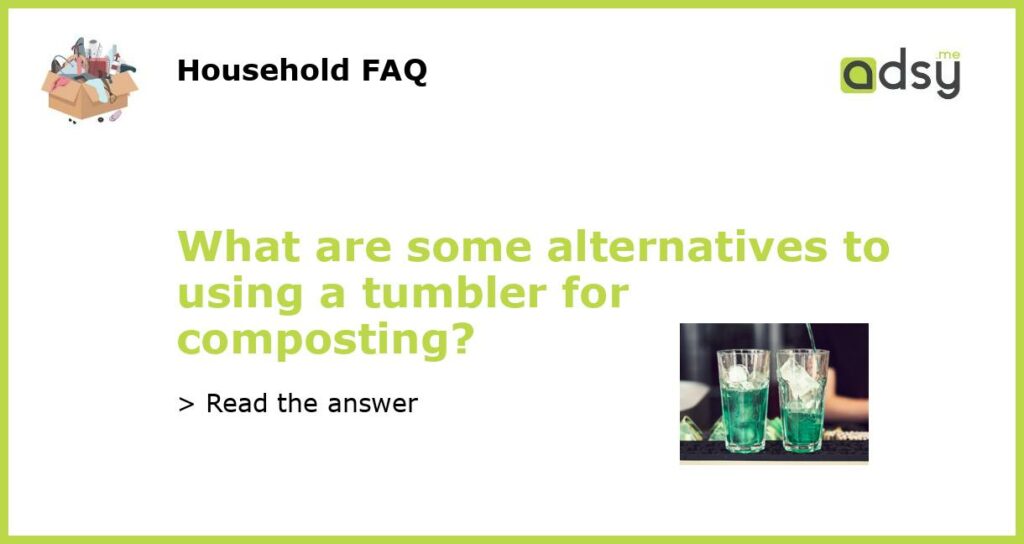Traditional compost pile
If you are looking for alternatives to using a tumbler for composting, one option is to create a traditional compost pile. This method involves layering organic materials such as kitchen scraps, yard waste, and garden debris directly on the ground. Over time, these materials will break down naturally, creating nutrient-rich compost.
To start a traditional compost pile, choose a location in your yard that is well-drained and receives partial sunlight. Begin by adding a layer of brown materials such as dried leaves or straw, followed by a layer of green materials such as kitchen scraps or grass clippings. Continue to alternate between brown and green layers, making sure to mix them together as you go.
It is important to regularly turn the compost pile with a pitchfork or shovel to aerate it and speed up the decomposition process. In a traditional compost pile, this turning process helps to mix the materials and create an even distribution of moisture and oxygen.
While a traditional compost pile may take longer to break down than a tumbler, it requires less maintenance and can accommodate larger quantities of organic waste. Additionally, the lack of a containment unit allows for better airflow, which can result in a more diverse microbial population and ultimately a higher-quality compost.
Compost bins
If you prefer a contained composting system, but don’t want to use a tumbler, consider using a compost bin. Compost bins come in various shapes and sizes, and can be made of materials such as wood, plastic, or wire mesh.
When using a compost bin, it is important to choose one with good ventilation, as this will promote airflow and help prevent odors. Many compost bins have open bottoms, allowing for direct contact with the soil and the beneficial microorganisms it contains.
To start composting in a bin, follow similar layering techniques as with a traditional compost pile. Add a balance of brown and green materials, and regularly turn the compost with a pitchfork or shovel to ensure even decomposition. Some bins also have built-in tumbling mechanisms, allowing for easier mixing and aeration.
Compost bins are a convenient option for those with limited space or concerns about aesthetics. They can be placed in a small corner of a backyard or even on a balcony or patio. Just make sure to choose a bin that suits your needs and composting goals.
Worm composting (vermicomposting)
Another alternative to using a tumbler is worm composting, also known as vermicomposting. This method involves using a specially designed worm bin and a specific type of earthworm called red worms (Eisenia fetida).
Worm composting is typically done indoors or in a sheltered outdoor area. The worms consume the organic waste placed in the bin, and their castings (also known as vermicast or worm castings) are then used as nutrient-rich fertilizer.
To get started with worm composting, you will need a worm bin with a solid bottom and several ventilation holes for airflow. Add bedding material such as shredded newspaper or cardboard, as well as some moistened soil or compost to provide the worms with a healthy environment.
Once your worm bin is set up, gradually introduce food scraps into the bin. Worms can eat a variety of organic waste, including fruit and vegetable scraps, coffee grounds, and tea bags. Avoid adding meat, dairy, or oily foods, as these can attract pests or cause unpleasant odors.
Worm composting is a great option for those who want to compost indoors or have limited outdoor space. It is also a fun educational activity for kids and can be a way to engage them in sustainable practices.
Bokashi composting
Bokashi composting is a unique method that allows you to compost all types of organic waste, including meat, dairy, and oily foods. It uses a specific type of microorganisms called effective microorganisms (EM) to ferment the waste, breaking it down into a pre-compost material.
To start bokashi composting, you will need a bokashi bin, which is an airtight container with a spigot at the bottom. The bin is filled with a bran-based mixture that has been inoculated with EM. After adding food waste to the bin, sprinkle a layer of the bran mixture on top and press it down to remove excess air.
The bokashi bin needs to be tightly sealed to create an anaerobic environment, which allows the fermentation process to take place. The waste in the bin will undergo fermentation for a few weeks, after which it can be buried in the soil or added to a traditional compost pile for further decomposition.
Bokashi composting is a great option for those who want to compost all types of organic waste and have limited outdoor space. It is a convenient and odor-free method, making it suitable for apartment dwellers or those with small yards.
Compost tea brewing
Compost tea brewing is an alternative method of using compost that does not involve a tumbler or traditional composting. Instead, it utilizes water to extract the beneficial microorganisms and nutrients from compost, creating a liquid fertilizer.
To make compost tea, place a generous amount of compost in a cloth or mesh bag and steep it in water for several hours or overnight. The water will absorb the microorganisms and plant nutrients from the compost, creating a nutrient-rich solution.
Once the brewing process is complete, use the compost tea to water your plants or use it as a foliar spray. The microorganisms in the tea help improve soil fertility, promote plant growth, and enhance disease resistance.
Compost tea brewing is a great option for those who want to maximize the benefits of compost without creating a traditional compost pile or using a tumbler. It can be done in small quantities or on a larger scale, depending on the size of your garden or the number of plants you want to treat.






